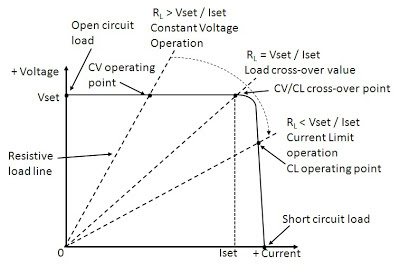Constant
Voltage/Constant Current (CC/CV) Power Supplies
In most of our discussions in “Watt’s Up?” on current
limiting we have primarily talked about power supplies as having a constant
current (CC) output characteristic. This is what is found in many lab and industrial
system power supplies, including most of the power supplies provided by us. Even
though the terms often get used interchangeably, there is actually a
distinction between constant current and current limit. To help explain this
distinction, Figure 1 illustrates the output characteristics of a constant
voltage/constant current (CV/CC) power supply.
Figure 1: Operating locus of a CC/CV power supply
Five operating points are depicted in Figure 1:
- With no load (i.e. infinite load resistance): Iout = 0 and Vout = Vset
- With a load resistance of RL > Vset/Iset: Iout = Vset/RL and Vout = Vset
- With a load resistance of RL = Vset/Iset: Iout = Iset and Vout = Vset
- With a load resistance of RL < Vset/Iset: Iout = Iset and Vout = Iset*RL
- With a short circuit (i.e. zero load resistance): Iout = Iset and Vout = 0
The advantage of a CV/CC power supply is it can be used as
either a voltage source or a current source, providing reasonable performance
in either mode. The point at which RL = Vset/Iset is the mode crossover point
where the power supply transitions between CV and CC operation. For a CV/CC
power supply there is a sharp transition between CV and CC operation. Note that
for an ideal CV/CC power supply the CV slope is zero (horizontal), indicating
zero output resistance for CV operation while the CC slope is infinite
(vertical), indicating infinite output resistance for CC operation. Note that
this is at DC. How close the slope of each mode is to ideal is what determines
quality of load regulation for each. To
achieve good performance for both CV and CC modes requires carefully designed
and more complex control loops for each mode. More details about using a power
supply as a current source is provided in an earlier posting here, entitled:
“Can a standard DC power supply be used as a current source?”
Constant
Voltage/Current Limiting Power Supplies
In comparison a constant voltage/current limiting (CV/CL)
power supplies are intended to be used only as a voltage source while providing
over-current protection for the DUT, as well as protection for the power supply
itself. Figure 2 depicts typical output characteristics of a CV/CL power
supply.
Figure 2: Operating locus of a CV/CL power supply
In CV/CL power supplies the current limit may be a fixed
maximum value or it may be settable. In comparison to Figure 1 CV operation is
still the same. However, what is found at the current limit cross-over point there
is loss of voltage regulation where the voltage starts falling off. Unlike true
CC operation in a CV/CC power supply, CL operation does not typically have as
sharply a defined cross-over point and once in CL it may not be tightly
regulated between the cross-over and short circuit points. The reason for this
is CL control circuits are usually more basic in nature in comparison to a true
CC control loop. CL is meant for over-current protection only, not CC operation. For this reason the correct use of CL is to
set its value a bit higher than the maximum current required by the DUT. This assures
good voltage regulation for the full range of normal loading. You may find many
of the more basic bench power supplies have CV/CL operation and may not be
useful as current sources as a result.
Reference: Agilent Technologies DC Power Supply Handbook,
application note AN-90B, part number 5952-4020



No comments:
Post a Comment
Note: Only a member of this blog may post a comment.